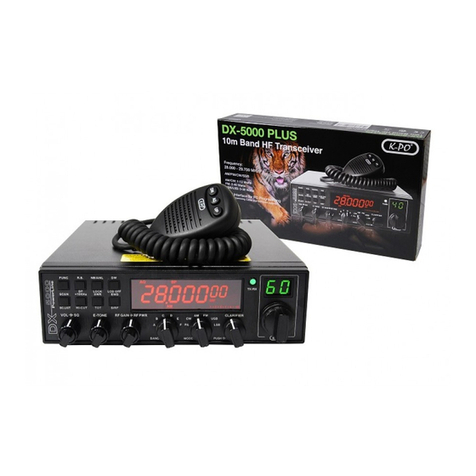
6
FUNC key, and then press other keys to realize the second functions
silk-screened under the button. "FUNC+ Keypad name" is to be used
in the following operating instruction.
16.
ROGER BEEP or BEEP FUNCTION
(1)RB
Press "RB" key to enable "ROGER BEEP" function with "RB" icon
appearing on LCD display. Press the key repeatedly to switch on/off
the function.
When RB function is enabled, the radio will automatically transmit the
audio signal at the end of your transmission. The listener can note
easily that your transmission is over through the signal.
(2)FUNC+RB
Press FUNC+RB to realize BP Function. It is a prompting function with
"BP" icon appearing on LCD display. Speaker would emit a BEEP for
prompting when press any key. press FUNC+RB repeatedly to switch
on/off the function.
17.
NB/ANL or LOCK
(1)Press NB/ANL key to enable NB/ANL function with "NB/ANL" icon
appearing on the LCD display. Press the key repeatedly to switch on/
off the function.
Noise Blanker/Automatic Noise Limiter. These filters allow reducing
back ground noises and some reception interferences.
(2)FUNC+NB/ANL
Press FUNC+NB/ANL to realize the Keyboard Lock function. When
this function is enabled, all keys are invalid except PTT, BAND
SWITCH, and MODE SWITCH. When pressing any key except PTT,
BAND SWITCH, MODE SWITCH, the LOCK icon will display on the
LCD. These situations indicate that the keyboard has been locked.
Press FUNC+NB/ANL repeatedly to switch on/off the function.
18.
DW or LCD OFF
(1)The DW (dual watch) function allows automatic alternate
monitoring of two channels. Refer to the following procedures to
enable this function.
To enable the DW function, firstly turn the SQ control clockwise
until the background noise is cut out. Select the first channel to be
monitored by using the CHANNEL SELECTOR knob or the channel
selector keys on the microphone. Press the DW key and the DW icon
will ash on the LCD display. Secondly, follow the above procedures
to select second channel to be monitored. Finally, press the DW key
again and the two monitoring channels will be alternately indicated on
the LCD. Radio will automatically start monitoring (scanning) the two
channels. When a signal is detected on one of the channels, scanning
stops and it is possible to listen the communications on that channel.
Press PTT to transmit on this channel. If there is no transmission
or detected signal on that channel within 5 seconds(time to resume
scanning can be programmed by PC software), radio will resume
scanning. When the DW function is enabled, the DW icon appears on
the LCD. To exit the DW function, press the DW key or the PTT key.
The scan Type above is the SQ mode under SCA Selection in
Function Menu. If TI mode is selected and valid signal is detected, the
radio would still start scanning when it is time to resume scanning,
whether there is signal or not in current channel.
(2)FUNC+DW
When this function is enabled, LCD display would be switched OFF
(LCD OFF).
Repeat this operation to switch ON/ OFF the function.
19.
SCAN or SCAN LIST
(1)SCAN
Automatic Scanning of busy channels.
Press the SCAN key to enable the SCAN function. Before enabling the
SCAN function, rstly turn the SQ control clockwise till the background
noise is cut out. Then press the SCAN key, radio will automatically
scan all channels continuously in the scan list and the SC icon will
appear on the LCD.
When a signal is detected on a channel, scanning stops on this





























